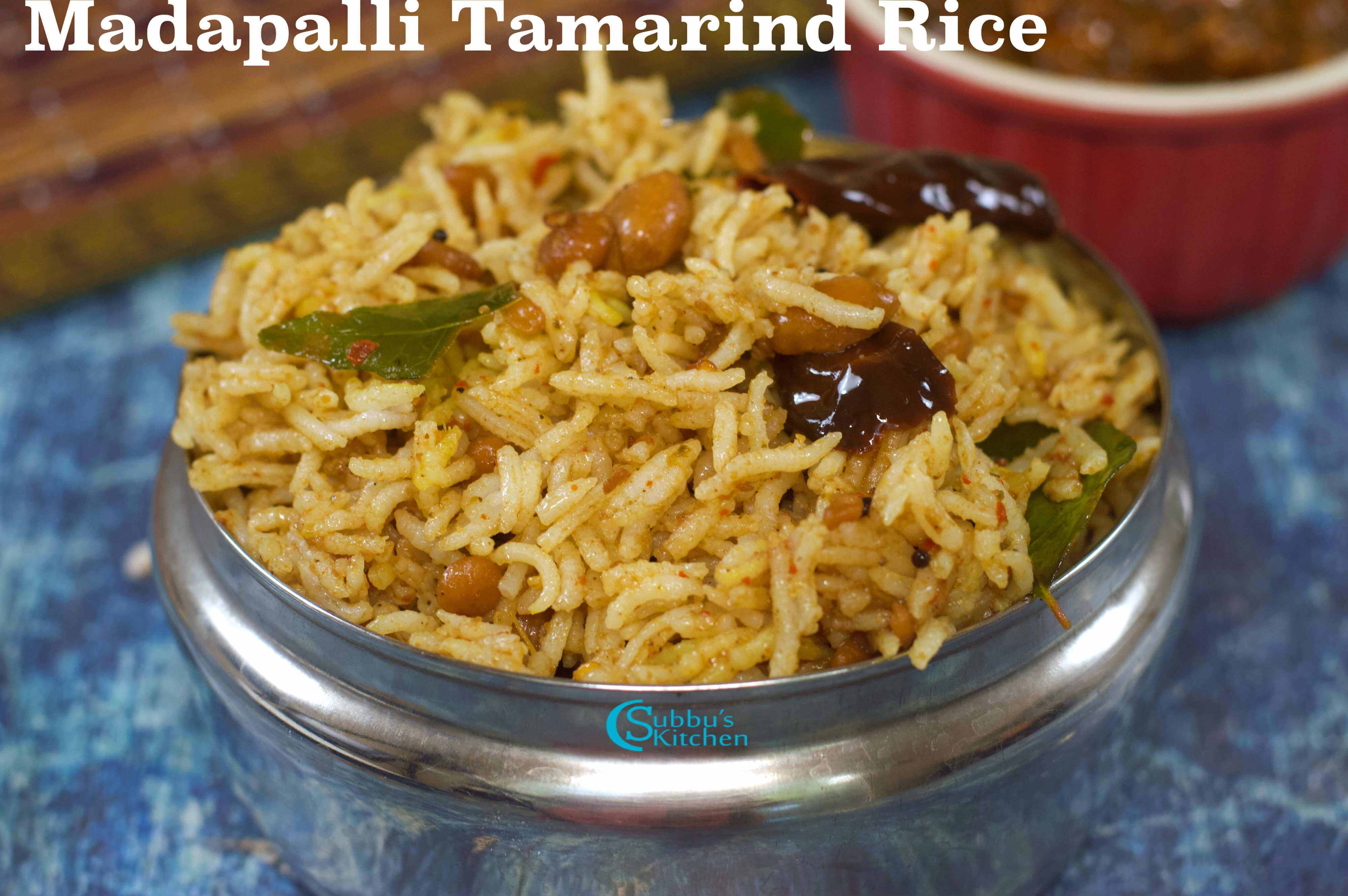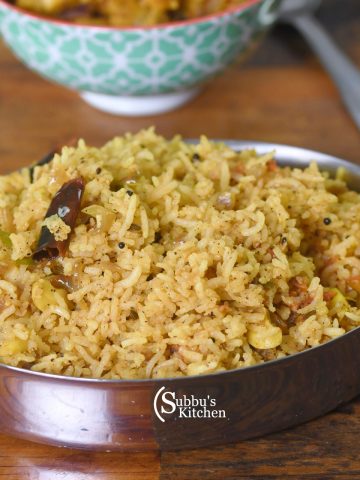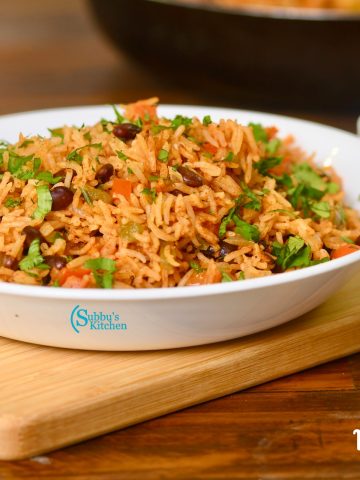Madapalli Puliyodharai | Temple Style Tamarind Rice is not just food – it’s a divine experience. This humble yet soul-satisfying rice dish is one of the most cherished prasads offered in Vishnu and Hanuman temples across the world. While many of us prepare tamarind rice at home, nothing truly compares to the unique flavor, aroma, and spiritual essence of temple-style puliyodharai. I was fortunate to learn this authentic recipe from a friend whose family is closely associated with the Divyadesams around Sirkazhi, where the madapalli (temple kitchen) recipes are preserved with utmost devotion. The result is a tangy, aromatic, and utterly addictive dish that tastes just like the puliyodharai served in Tirumala Madapalli—an offering so divine, it lingers in your memory long after the last bite.

Madapalli Puliyodharai is a temple staple and is served as prasad year-round, but it gains extra significance during Vaikunta Ekadasi, Purattasi Saturdays (dedicated to Lord Venkateswara), Hanuman Jayanthi, and other major temple festivals. In many homes, it’s also a go-to offering for Navaratri, Aadi Perukku, and special pujas, since it keeps well without refrigeration and is perfect for distributing as prasadam to devotees. The long shelf life of tamarind rice makes it a traditional favorite for festivals, temple gatherings, and travel food too.
Jump to:
What’s Special about Temple Puliyodharai?
We’ve all wondered why temple prasad tastes so irresistibly delicious. In most large temples, there is a dedicated madapalli (temple kitchen) where prasadam is prepared fresh in large quantities every single day. I truly believe that the divine blessings infused in the cooking make the prasadam extra special. Beyond that, the process itself adds to the magic—cooking in traditional uruli (large bronze vessels) over an open flame imparts a subtle smoky flavor, elevating the taste of rice, pongal, or any other prasadam served in temples. It’s this unique combination of devotion, tradition, and technique that makes temple-style puliyodharai so unforgettable.
Ingredients
Every component of Madapalli Puliyodharai is thoughtfully chosen to craft that revered, temple-style flavor:
- Tamarind brings the essential tang that makes this rice both soul-soothing and vibrant.
- A balanced mix of dal, spices, and asafoetida in the spice powder adds depth, aroma, and a savory complexity that’s far more nuanced than basic seasonings.
- The first tempering, with sesame oil, legumes, peanuts, and chilies, contributes rich texture, gentle heat, and an inviting nuttiness that gives the dish its crunchy, golden charm.
- The second tempering—mustard seeds, turmeric, and curry leaves in aromatic oil—adds layers of fragrance, warmth, and a final burst of flavor.
- Sesame oil isn’t just any cooking medium; its distinctive nutty aroma is critical to that authentic temple fragrance.
- Cooked rice, ideally soft yet firm (Ponni or Sona Masoori), acts as the canvas for these bold flavors.
Together, this ensemble of ingredients produces a temple-style puliyodharai that's savory, tangy, aromatic, and textured—perfect for prasadam, festivals, or a soul-hugging meal.
See recipe card for quantities.
Instructions

- Soak the tamarind in warm water for about 10 minutes and extract a thick juice. Alternatively, you can dissolve 2 tablespoons of tamarind paste in 1 cup of water and set it aside.

- Heat a pan and dry roast all the ingredients—urad dal, channa dal, fenugreek seeds, peppercorns, red chilies, asafoetida, and curry leaves—until the dals turn golden brown and release a fragrant aroma..

- Allow the roasted mixture to cool completely, then transfer it to a mixer jar and grind into a fine powder. Set this spice powder aside for later use.

- Heat oil in a pan. Once hot, add split urad dal, channa dal, peanuts, curry leaves, asafoetida, and red chilies. Sauté until the dals turn golden brown and aromatic.
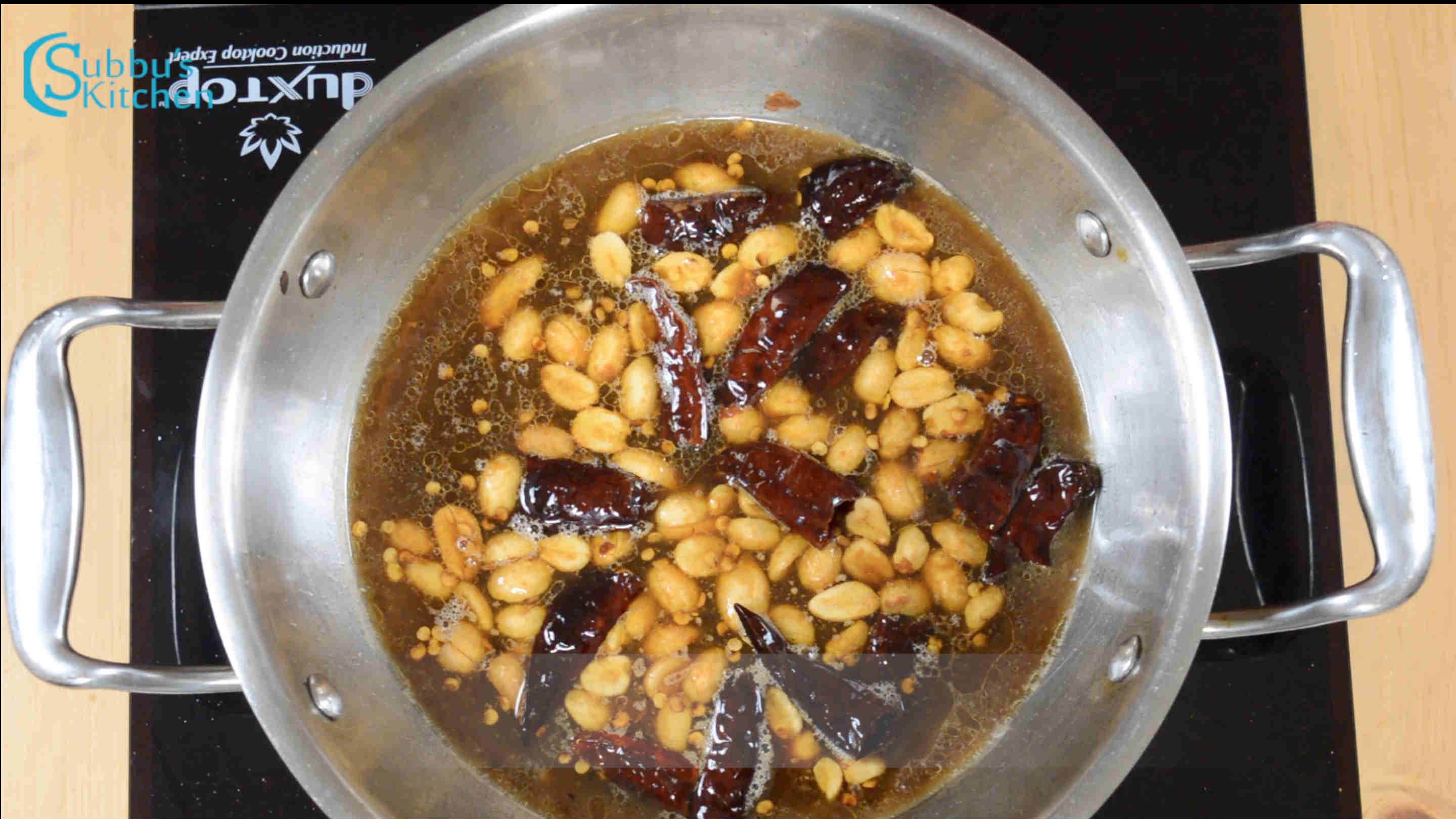
- Add the tamarind juice along with salt and let it boil for about 10 minutes.
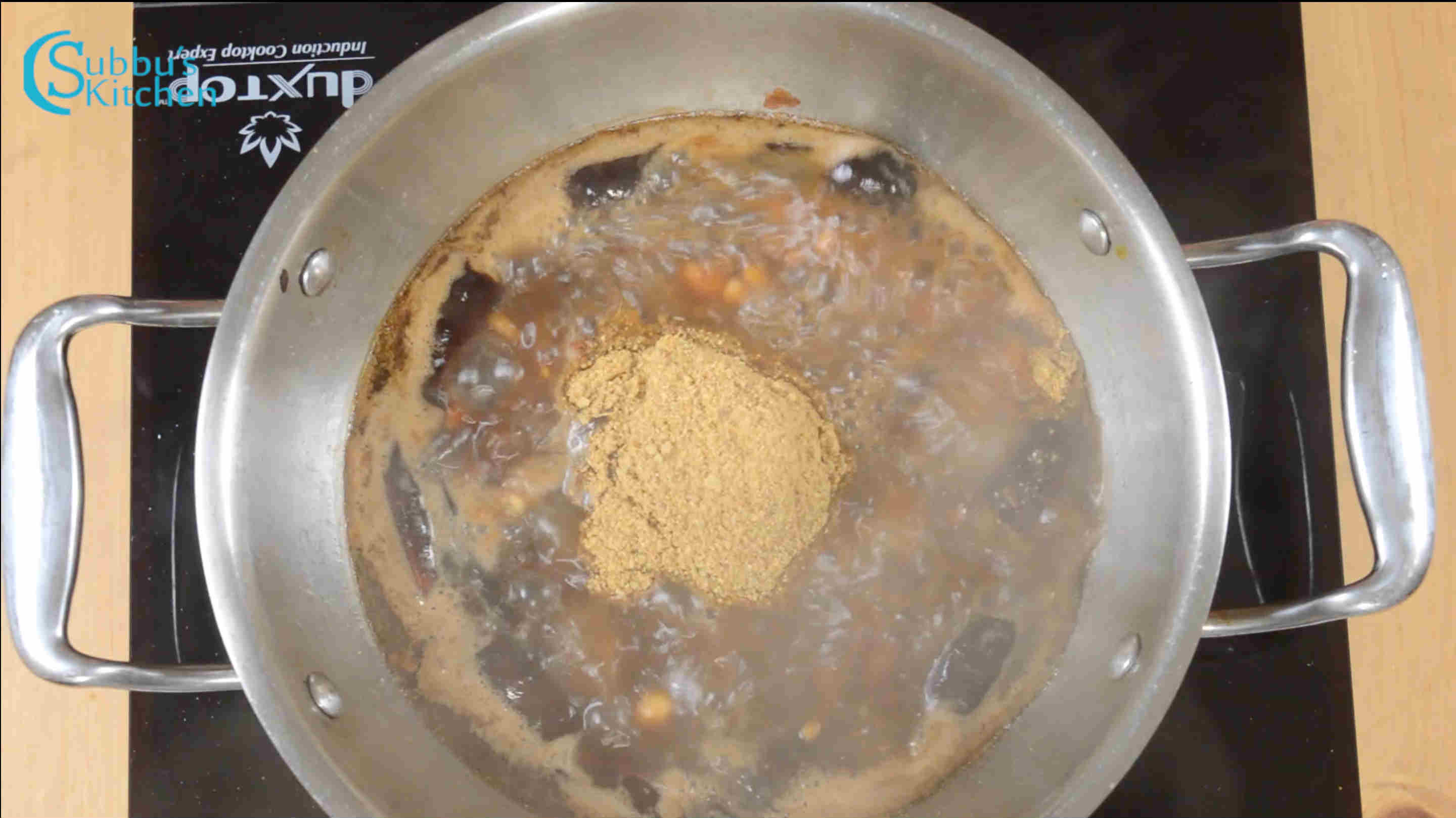
- After it has reduced slightly, add the prepared spice powder and mix well. Stir continuously to ensure the powder blends smoothly with the tamarind base—otherwise, lumps may form.

- Keep stirring and allow the mixture to simmer on a low flame until it thickens into a paste. Once the Puliyodharai mix reaches a thick consistency, switch off the flame.

- Step 2: Form into ball shape with your hands

- Heat oil in another pan and add mustard seeds. Allow them to crackle. Next, add turmeric powder and curry leaves, mix briefly, and switch off the flame.

- Pour this tempering over the Puliyodharai mixture. Your delicious Madapalli Puliyodharai is now ready to serve!

- Spread the cooked rice in a wide plate or bowl. Add a little salt and sesame oil—keep in mind that the Puliyodharai mix already contains salt, so just about ¼ teaspoon is enough—and mix gently. Spoon in 3–4 tablespoons of the Puliyodharai mixture and fold it into the rice carefully.

- Your Temple Style Tamarind Rice is now ready to serve!”
Hint: When preparing the spice powder, ensure you roast the dals and spices evenly on medium heat. This brings out the aroma and prevents any bitterness. Also, always stir continuously when mixing the Puliyodharai paste with the spice powder to avoid lumps.
Variations
1. Iyengar-Style Puliyodharai
This traditional version includes roasted sesame seeds, adding a nutty aroma and flavor. It's commonly served as prasadam in temples.
2. Andhra Pulihora
A spicier variant from Andhra Pradesh, this version incorporates green chilies and ginger, offering a zesty kick. It's quick to prepare and perfect for lunchboxes.
3. Karnataka Puliyogare
In this Karnataka-style tamarind rice, dry coconut (kopra) and mustard seeds are added to the spice mix, creating a distinct flavor profile. It's a delightful twist on the traditional recipe.
4. Pacha Puli Sadam (Instant Raw Tamarind Rice)
For a quick fix, this recipe uses raw tamarind and red chili paste mixed directly with hot rice, eliminating the need for boiling tamarind. It's ideal for busy days or travel.
Storage
- Store the Puliyodharai paste in an airtight container in the refrigerator. It will stay fresh for up to 5–6 days.
- Keep the cooked rice separate from the paste if storing longer, and combine just before serving to maintain the best texture and flavor.
- This dish does not freeze well, as the texture and taste of tamarind rice may change upon thawing.
- For best results, always reheat gently on a low flame or in a microwave before serving.
Top Tip
If you're going to make this recipe, make sure to follow this top tip!
The secret to a perfect temple-style Puliyodharai lies in roasting the spice ingredients evenly and stirring continuously when mixing the spice powder with the tamarind juice. This prevents lumps, brings out the full aroma of the spices, and ensures a smooth, flavorful paste. Also, simmer gently on low heat—overcooking can make the paste too thick or bitter.
Related
Looking for other recipes like this? Try these:
Pairing
- Serve hot with a dollop of ghee for an extra aromatic and rich flavor, just like in temples.
- Pair with papad (appalam), pickle, or yogurt (curd) to balance the tanginess.
- Garnish with freshly roasted sesame seeds or a few curry leaves for added aroma and texture.
- This tamarind rice also makes a perfect prasadam or festive dish for Navaratri, Vaikunta Ekadasi, or special poojas.
- For a lighter meal, enjoy it with vegetable stir-fries
Recipe Card
Madapalli Puliyodharai | Temple Style Tamarind Rice
Equipments Needed
- 1 Heavy Bottomed Pan
- 1 Mixer Grinder
Ingredients
- 1 Lemon Size Tamarind or 2 Tablespoon Tamarind Paste
- 1½ teaspoon Salt Adjust to your taste
For Spice Powder
- 1 teaspoon Urad Dal
- 1 teaspoon Split Bengal Gram (Channa Dal / Kadalaparuppu)
- ½ teaspoon Fenugreek seeds
- 1 teaspoon Peppercorns
- 10 Red Chili
- 1 Pinch Asafoetida (Asafetida / Hing)
- 1 sprig Curry leaves
First Tempering
- 3 tablespoon Sesame Oil
- 2 teaspoon Split Urad Dal
- 2 teaspoon Split Bengal Gram (Channa Dal / Kadalaparuppu)
- 1 tablespoon Peanuts
- 6 nos Red Chili
- 1 pinch Asafoetida (Asafetida / Hing)
Second Tempering
- 1 tablespoon Sesame Oil
- 1 teaspoon Mustard Seeds
- ½ teaspoon Turmeric Powder
- 1 sprig Curry Leaves
Tamarind Rice
- 2 Cups Cooked Rice
- ½ teaspoon Salt adjust to your taste
- 1 teaspoon Sesame Oil
- 1 sprig Curry Leaves
Instructions
Prepare Tamarind Juice
- Soak the tamarind in warm water for about 10 minutes and extract thick juice. Alternatively, dissolve 2 tablespoons of tamarind paste in 1 cup of water and set aside.1 Lemon Size Tamarind
Make the Spice Powder
- Heat a pan and dry roast urad dal, channa dal, fenugreek seeds, peppercorns, red chilies, asafoetida, and curry leaves until the dals turn golden brown and aromatic.1 teaspoon Urad Dal, 1 teaspoon Split Bengal Gram (Channa Dal / Kadalaparuppu), ½ teaspoon Fenugreek seeds, 1 teaspoon Peppercorns, 10 Red Chili, 1 Pinch Asafoetida (Asafetida / Hing), 1 sprig Curry leaves
- Let the mixture cool completely, then grind into a fine powder using a mixer. Set aside.
First Tempering
- Heat sesame oil in a pan. Add split urad dal, channa dal, peanuts, red chilies, curry leaves, and a pinch of asafoetida.3 tablespoon Sesame Oil, 2 teaspoon Split Urad Dal, 2 teaspoon Split Bengal Gram (Channa Dal / Kadalaparuppu), 1 tablespoon Peanuts, 6 nos Red Chili, 1 sprig Curry Leaves, 1 pinch Asafoetida (Asafetida / Hing)
- Sauté until the dals turn golden brown and aromatic.
Cook Tamarind Base
- Add the tamarind juice and salt to the pan and bring it to a boil for about 10 minutes.1½ teaspoon Salt
- Stir in the prepared spice powder gradually, mixing continuously to avoid lumps.
- Simmer on very low flame until the mixture thickens into a paste. Switch off the flame once thick.
Second Tempering
- In another small pan, heat sesame oil and add mustard seeds. Allow them to crackle.1 tablespoon Sesame Oil, 1 teaspoon Mustard Seeds
- Add turmeric powder and curry leaves, mix briefly, and switch off the flame.½ teaspoon Turmeric Powder, 1 sprig Curry Leaves
- Pour this tempering over the Puliyodharai mixture
Assemble with Rice
- Spread the cooked rice in a wide plate or bowl.2 Cups Cooked Rice
- Add ¼ teaspoon of salt and a little sesame oil, mixing gently.½ teaspoon Salt, 1 teaspoon Sesame Oil
- Add 3–4 tablespoons of Puliyodharai mixture and fold gently into the rice. Add more if desired, mixing carefully to coat the rice evenly.
- Temple Style Tamarind Rice is now ready to serve!
Video
Notes
Tips for Perfect Madapalli Puliyodharai
- Use fresh tamarind – Fresh tamarind or good-quality paste gives the best tangy flavor. Avoid overly processed tamarind pastes as they can be too sweet or diluted.
- Roast the spices properly – Dry roast the dals and spices until golden and aromatic; under-roasting can make the spice powder bland.
- Mix spice powder slowly – Always stir continuously when adding the spice powder to tamarind juice to avoid lumps.
- Simmer on low heat – Allow the Puliyodharai paste to thicken gently; high heat may make it bitter.
- Use freshly cooked rice – Slightly firm, warm rice absorbs the flavors better. Avoid rice that’s too soft or overcooked.
- Tempering makes a difference – Don’t skip the second tempering with mustard, turmeric, and curry leaves—it adds authentic temple aroma.
- Adjust tanginess and spice – Taste and tweak tamarind or red chili according to preference.
- Storage tip – Store paste and rice separately for best results if making ahead; recombine before serving.
Nutritional Info
